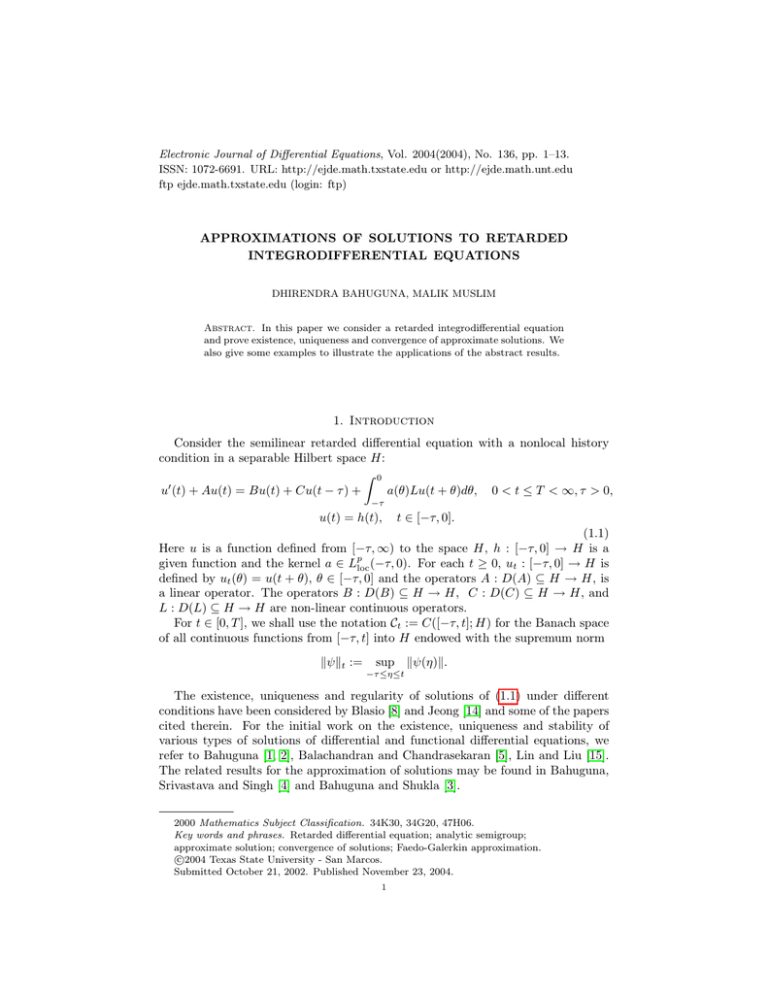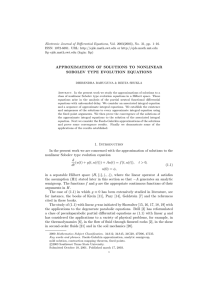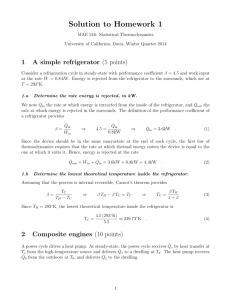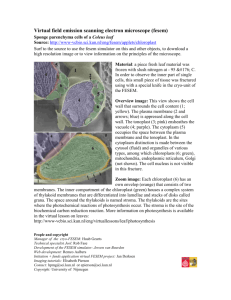Electronic Journal of Differential Equations, Vol. 2004(2004), No. 136, pp.... ISSN: 1072-6691. URL: or
advertisement

Electronic Journal of Differential Equations, Vol. 2004(2004), No. 136, pp. 1–13.
ISSN: 1072-6691. URL: http://ejde.math.txstate.edu or http://ejde.math.unt.edu
ftp ejde.math.txstate.edu (login: ftp)
APPROXIMATIONS OF SOLUTIONS TO RETARDED
INTEGRODIFFERENTIAL EQUATIONS
DHIRENDRA BAHUGUNA, MALIK MUSLIM
Abstract. In this paper we consider a retarded integrodifferential equation
and prove existence, uniqueness and convergence of approximate solutions. We
also give some examples to illustrate the applications of the abstract results.
1. Introduction
Consider the semilinear retarded differential equation with a nonlocal history
condition in a separable Hilbert space H:
Z 0
u0 (t) + Au(t) = Bu(t) + Cu(t − τ ) +
a(θ)Lu(t + θ)dθ, 0 < t ≤ T < ∞, τ > 0,
−τ
u(t) = h(t),
t ∈ [−τ, 0].
(1.1)
Here u is a function defined from [−τ, ∞) to the space H, h : [−τ, 0] → H is a
given function and the kernel a ∈ Lploc (−τ, 0). For each t ≥ 0, ut : [−τ, 0] → H is
defined by ut (θ) = u(t + θ), θ ∈ [−τ, 0] and the operators A : D(A) ⊆ H → H, is
a linear operator. The operators B : D(B) ⊆ H → H, C : D(C) ⊆ H → H, and
L : D(L) ⊆ H → H are non-linear continuous operators.
For t ∈ [0, T ], we shall use the notation Ct := C([−τ, t]; H) for the Banach space
of all continuous functions from [−τ, t] into H endowed with the supremum norm
kψkt :=
sup kψ(η)k.
−τ ≤η≤t
The existence, uniqueness and regularity of solutions of (1.1) under different
conditions have been considered by Blasio [8] and Jeong [14] and some of the papers
cited therein. For the initial work on the existence, uniqueness and stability of
various types of solutions of differential and functional differential equations, we
refer to Bahuguna [1, 2], Balachandran and Chandrasekaran [5], Lin and Liu [15].
The related results for the approximation of solutions may be found in Bahuguna,
Srivastava and Singh [4] and Bahuguna and Shukla [3].
2000 Mathematics Subject Classification. 34K30, 34G20, 47H06.
Key words and phrases. Retarded differential equation; analytic semigroup;
approximate solution; convergence of solutions; Faedo-Galerkin approximation.
c
2004
Texas State University - San Marcos.
Submitted October 21, 2002. Published November 23, 2004.
1
2
D. BAHUGUNA, M. MUSLIM
EJDE-2004/136
Initial study concerning existence, uniqueness and finite-time blow-up of solutions for the following equation,
u0 (t) + Au(t) = g(u(t)),
t ≥ 0,
u(0) = φ,
(1.2)
have been considered by Segal [19], Murakami [17], Heinz and von Wahl [13]. Bazley
[6, 7] has considered the following semilinear wave equation
u00 (t) + Au(t) = g(u(t)),
u(0) = φ,
t ≥ 0,
0
u (0) = ψ,
(1.3)
and has established the uniform convergence of approximations of solutions to (1.3)
using the existence results of Heinz and von Wahl [13]. Goethel [12] has proved the
convergence of approximations of solutions to (1.2) but assumed g to be defined on
the whole of H. Based on the ideas of Bazley [6, 7], Miletta [16] has proved the
convergence of approximations to solutions of (1.2). In the present work, we use
the ideas of Miletta [16] and Bahuguna [3, 4] to establish the convergence of finite
dimensional approximations of the solutions to (1.1).
2. Preliminaries and Assumptions
Existence of a solution to (1.1) is closely associated with the existence of a
function u ∈ CT̃ , 0 < T̃ ≤ T satisfying
t ∈ [−τ, 0],
h(t),
R
t
u(t) = e−tA h(0) + e−(t−s)A [Bu(s)
0 R
0
+Cu(s − τ ) + −τ a(θ)Lu(s + θ)dθ]ds, t ∈ [0, T̃ ]
and such a function u is called a mild solution of (1.1) on [−τ, T̃ ]. A function u ∈ CT̃
is called a classical solution of (1.1) on [−τ, T̃ ] if u ∈ C 1 ((0, T̃ ]; H) and u satisfies
(1.1) on [−τ, T̃ ].
We assume in (1.1), that the linear operator A satisfies the following.
(H1) A is a closed, positive definite, self-adjoint linear operator from the domain
D(A) ⊂ H into H such that D(A) is dense in H, A has the pure point
spectrum
0 < λ0 ≤ λ1 ≤ λ2 ≤ . . .
and a corresponding complete orthonormal system of eigenfunctions {φi },
i.e.,
Aφi = λi φi and (φi , φj ) = δij ,
where δij = 1 if i = j and zero otherwise.
If (H1) is satisfied then −A is the infinitesimal generator of an analytic semigroup
{e−tA : t ≥ 0} in H (cf. Pazy [18, pp. 60-69]). It follows that the fractional powers
Aα of A for 0 ≤ α ≤ 1 are well defined from D(Aα ) ⊆ H into H (cf. Pazy [18, pp.
69-75]). Hence for convenience, we suppose that
ke−tA k ≤ M
for all t ≥ 0
and 0 ∈ ρ(−A), where ρ(−A) is the resolvent set of −A.
D(Aα ) is a Banach space endowed with the norm kxkα = kAα xk.
EJDE-2004/136
APPROXIMATIONS OF SOLUTIONS
3
For t ∈ [0, T ], we denote by Ctα := C([−τ, t]; D(Aα )) endowed with the norm
kψkt,α :=
sup kψ(ν)kα .
−τ ≤ν≤t
Further, we assume the following.
(H2) h ∈ C0α and h is locally hölder continuous on [−τ, 0].
(H3) We shall assume that the map B : D(Aα ) → H satisfies the following
Lipschitz condition on balls in D(Aα ): for each η > 0 and some 0 < α < 1
there exists a constant K1 (η) such that
(i) kB(ψ)k ≤ K1 (η) for ψ ∈ D(Aα ) with kAα ψk ≤ η,
(ii) kB(ψ1 ) − B(ψ2 )k ≤ K1 (η)kAα (ψ1 − ψ2 )k for ψ1 , ψ2 ∈ D(Aα ) with
kAα ψi k ≤ η for i = 1, 2.
(H4) The map C : D(Aα ) → H satisfies the following Lipschitz condition on
balls in D(Aα ): For each η > 0 and some 0 < α < 1 there exists a constant
K2 (η) such that
(iii) kC(ψ)k ≤ K2 (η) for ψ ∈ D(Aα ) with kAα ψk ≤ η,
(iv) kC(ψ1 ) − C(ψ2 )k ≤ K2 (η)kAα (ψ1 − ψ2 )k for ψ1 , ψ2 ∈ D(Aα ) with
kAα ψi k ≤ η for i = 1, 2.
(H5) The map L : D(Aα ) → H satisfies the following Lipschitz condition on
balls in D(Aα ): For each η > 0 and some 0 < α < 1 there exists a constant
K3 (η) such that
(v) kL(ψ)k ≤ K3 (η) for ψ ∈ D(Aα ) with kAα ψk ≤ η,
(vi) kL(ψ1 ) − L(ψ2 )k ≤ K3 (η)kAα (ψ1 − ψ2 )k for ψ1 , ψ2 ∈ D(Aα ) with
kAα ψi k ≤ η for i = 1, 2.
R0
(H6) a ∈ Lploc (−τ, 0) for some 1 < p < ∞ and aT = −τ |a(θ)| dθ.
3. Approximate Solutions and Convergence
Let Hn denote the finite dimensional subspace of H spanned by {φ0 , φ1 , · · · , φn }
and let P n : H −→ Hn be the corresponding projection operator for n = 0, 1, 2, · · · .
Let 0 < T0 ≤ T be such that
R
(3.1)
sup k(e−tA − I)Aα h(0)k ≤ ,
2
0≤t≤T0
where R > 0 be a fixed quantity.
Let us define
(
h(t), if t ∈ [−τ, 0],
h̄(t) =
h(0), if t ∈ [0, T ].
We set
R
1
1 1
T0 < min { (1 − α)(K(η0 )Cα )−1 } 1−α , { (1 − α)(K(η0 )Cα )−1 } 1−α ,
2
2
where
K(η0 ) = [K1 (η0 ) + K2 (η0 ) + K3 (η0 )aT ]
α −tA
and Cα is a positive constant such that kA e
k ≤ Cα t
Bn : H −→ H such that
Bn x = BP n x, x ∈ H.
Similarly Cn and Ln are given by
Cn x = CP n x, x ∈ H,
−α
(3.2)
(3.3)
for t > 0. We define
Ln x = LP n x, x ∈ H.
4
D. BAHUGUNA, M. MUSLIM
EJDE-2004/136
Let Aα : Ctα → Ct be given by (Aα ψ)(s) = Aα (ψ(s)), s ∈ [−τ, t], t ∈ [0, T ]. We
define a map Fn on BR (CTα0 , h̄) as follows
t ∈ [−τ, 0],
h(t),
R t −(t−s)A
−tA
(Fn u)(t) = e
[Bn u(s)
h(0) + 0 e
R0
+Cn u(s − τ ) + −τ a(θ)Ln u(s + θ)dθ]ds, t ∈ [0, T0 ],
for u ∈ BR (CTα0 , h̄).
Theorem 3.1. Suppose that the conditions (H1)-(H6) are satisfied and h(t) ∈
D(A) for all t ∈ [−τ, 0]. Then there exists a unique un ∈ BR (CTα0 , h̄) such that
Fn un = un for each n = 0, 1, 2, · · · , i.e., un satisfies the approximate integral
equation
h(t),
R
un (t) = e−tA h(0) + t e−(t−s)A [Bn un (s)
0
R0
+Cn un (s − τ ) + −τ a(θ)Ln un (s + θ)dθ]ds,
t ∈ [−τ, 0],
(3.4)
t ∈ [0, T0 ].
Proof. First we show that Fn : BR (CTα0 , h̄) → BR (CTα0 , h̄). For this first we need
to show that the map t 7→ (Fn u)(t) is continuous from [−τ, T0 ] into D(Aα ) with
respect to k · kα norm. Thus for any u ∈ BR (CTα0 , h̄), and t1 , t2 ∈ [−τ, 0], we have
(Fn u)(t1 ) − (Fn u)(t2 ) = h(t1 ) − h(t2 ).
(3.5)
Now for t1 t2 ∈ (0, T0 ] with t1 < t2 we have
k(Fn u)(t2 ) − (Fn u)(t1 )kα
≤ k(e−t2 A − e−t1 A )h(0)kα +
Z
t1
k(e−(t2 −s)A − e−(t1 −s)A )Aα k
0
× kBn u(s)k + kCn u(s − τ )k +
Z
0
|a(θ)|kLn u(s + θ)kdθ ds
−τ
Z
t2
+
(3.6)
k(e−(t2 −s)A )Aα k kBn u(s)k + kCn u(s − τ )k
t1
0
Z
+
|a(θ)|kLn u(s + θ)kdθ ds.
−τ
Since part (d) of Theorem 6.13 in Pazy [18, p. 74] states that for 0 < β ≤ 1 and
x ∈ D(Aβ ),
k(e−tA − I)xk ≤ Cβ tβ kAβ xk.
Hence if 0 < β < 1 is such that 0 < α + β < 1 then Aα y ∈ D(Aβ ). Therefore for
t, s ∈ (0, T0 ], we have
k(e−tA − I)Aα e−sA xk ≤ Cβ tβ kAα+β e−sA xk ≤ Cβ Cα+β tβ s−(α+β) kxk.
(3.7)
EJDE-2004/136
APPROXIMATIONS OF SOLUTIONS
5
We use the inequality (3.7) to obtain
Z t1
k(e−(t2 −s)A − e−(t1 −s)A )Aα k[kBn u(s)k + kCn u(s − τ )k
0
0
Z
|a(θ)|kLn u(s + θ)kdθ]ds
+
−τ
t1
Z
≤
k(e−(t2 −t1 )A − I)e−(t1 −s)A Aα k[kBn u(s)k + kCn u(s − τ )k
(3.8)
0
Z
0
|a(θ)|kLn u(s + θ)kdθ]ds
+
−τ
≤ Cα,β (t2 − t1 )β ,
where
1−(α+β)
Cα,β = Cβ Cα+β K(η0 )
T0
,
[1 − (α + β)]
K(η0 ) is given by (3.3) and η0 = R + khk0,α . We calculate the second part of the
integral (3.6) as follows. We have
Z t2
Z 0
ke−(t2 −s)A Aα k[kBn u(s)k + kCn u(s − τ )k +
|a(θ)|kLn u(s + θ)kdθ]ds
−τ
t1
(t2 − t1 )1−α
≤ Cα K(η0 )
.
(1 − α)
(3.9)
Hence from (3.5), (3.8) and (3.9) the map t 7→ (Fn u)(t) is continuous from [−τ, T0 ]
into D(Aα ) with respect to k · kα norm.
Now, for t ∈ [−τ, 0], (Fn u)(t) − h̄(t) = 0.
For t ∈ (0, T0 ], we have
k(Fn u)(t) − h̄(t)kα
≤ k(e−tA − I)Aα h(0)k
Z
Z t
+
ke−(t−s)A Aα k kBn u(s)k + kCn u(s − τ )k +
|a(θ)|kLn u(s + θ)kdθ ds
−τ
0
≤
0
T01−α
R
+ Cα K(η0 )
.
2
1−α
Hence kFn u − h̄kT0 ,α ≤ R. Thus Fn : BR (CTα0 , h̄) → BR (CTα0 , h̄).
Now, for any u, v ∈ BR (CTα0 , h̄) and t ∈ [−τ, 0] we have Fn u(t) − Fn v(t) = 0. For
t ∈ (0, T0 ] and u, v ∈ BR (CTα0 , h̄) we have
kFn u(t) − Fn v(t)kα
Z t
h
≤
ke−(t−s)A Aα k kBn u(s) − Bn v(s)k + kCn u(s − τ ) − Cn v(s − τ )k
0
Z
0
+
i
|a(θ)|kLn u(s + θ) − Ln v(s + θ)kdθ ds
−τ
Z
≤
0
t
Cα (t − s)−α [K1 (η0 )ku(s) − v(s)kα + K2 (η0 )ku(s − τ ) − v(s − τ )kα
6
D. BAHUGUNA, M. MUSLIM
Z
EJDE-2004/136
0
|a(θ)|K3 (η0 )ku(s + θ) − v(s + θ)kα dθ]ds
+
−τ
Z
≤
t
Cα (t − s)−α K(η0 )ku − vkT0 ,α ds
0
1
ku − vkT0 ,α .
2
Taking the supremum on t over [−τ, T0 ] we get
≤
1
ku − vkT0 ,α .
2
Hence there exists a unique un ∈ BR (CTα0 , h̄) such that Fn un = un , which satisfies
the approximate integral equation (3.4). This completes the proof of Theorem 3.1.
kFn u − Fn vkT0 ,α ≤
Corollary 3.2. If all the hypotheses of the Theorem 3.1 are satisfied then un (t) ∈
D(Aβ ) for all t ∈ [−τ, T0 ] where 0 ≤ β < 1.
Proof. From Theorem 3.1 there exists a unique un ∈ BR (CTα0 , h̄) satisfying (3.4).
From [18, Theorem 1.2.4] we have that e−tA x ∈ D(A) for x ∈ D(A). Also from Part
(a) of [18, Theorem 2.6.13] we have e−tA : H 7→ D(Aβ ) for t > 0 and 0 ≤ β < 1.
Hölder continuity of un follows from the similar arguments as used in (3.8) and
(3.9). From [18, Theorem 4.3.2], for 0 < t < T , we have
Z t
e−(t−s)A f (s)ds ∈ D(A).
0
β
Since D(A) ⊆ D(A ) for 0 ≤ β ≤ 1, the result of Corollary 3.2 thus follows.
Corollary 3.3. If h(0) ∈ D(Aα ), where 0 < α < 1 and t0 ∈ (0, T0 ] then there
exists a constant Mt0 , independent of n, such that
kAβ un (t)k ≤ Mt0
for all t0 ≤ t ≤ T0 and 0 ≤ β < 1. Furthermore if h(t) ∈ D(A) for all t ∈ [−τ, 0]
then there exist a constant M0 , independent on n, such that
kAβ un (t)k ≤ M0
for all −τ ≤ t ≤ T0 and 0 ≤ β < 1.
Proof. For any t0 ∈ (0, T0 ], we have,
kun (t)kβ ≤ Cβ t−β
0 kh(0)k + Cβ K(η0 )
T01−β
≤ Mt0 .
1−β
Now as h(t) ∈ D(A) for all t ∈ [−τ, 0] hence h(t) ∈ D(Aβ ) for all t ∈ [−τ, 0] so for
any t ∈ [−τ, 0], we have
kun (t)kβ = kAβ h(t)k ≤ khk0,β
for all t ∈ [−τ, 0].
Now again for any t ∈ (0, T0 ] we have
kun (t)kβ ≤ M khk0,β + Cβ K(η0 )
This completes the proof of the Corollary 3.3.
T01−β
.
1−β
(3.10)
EJDE-2004/136
APPROXIMATIONS OF SOLUTIONS
7
Theorem 3.4. Suppose that the conditions (H1)-(H6) are satisfied and h(t) ∈
D(A) for all t ∈ [−τ, 0]. Then the sequence {un } ⊂ CTα0 is a Cauchy sequence and
therefore converges to a function u ∈ CTα0 .
Proof. For n ≥ m ≥ n0 , where n0 is large enough, n, m, n0 ∈ N, t ∈ [−τ, 0] we have
kun (t) − um (t)kα = kh(t) − h(t)kα = 0.
For t ∈ (0, T0 ] and n, m and n0 as above we have
Z t
kun (t) − um (t)kα ≤
ke−(t−s)A Aα k[kBn un (s) − Bm um (s)k
(3.11)
0
+ kCn un (s − τ ) − Cm um (s − τ )k
Z 0
+
|a(θ)|kLn un (s + θ) − Lm um (s + θ)kdθ]ds.
−τ
For 0 < t00 < t0 , we have
Z
kun (t) − um (t)kα ≤ (
t00
Z
t
)ke−(t−s)A Aα k[kBn un (s) − Bm um (s)k
+
t00
0
+ kCn un (s − τ ) − Cm um (s − τ )k
Z 0
+
|a(θ)|kLn un (s + θ) − Lm um (s + θ)kdθ]ds.
(3.12)
−τ
Now for 0 < α < β < 1, we have
k[Bn (un (s)) − Bm (um (s))]k
≤ kBn (un (s)) − Bn (um (s))k + kBn (um (s)) − Bm (um (s))k
≤ K1 (η0 )kAα [un (s) − um (s)]k + K1 (η0 )kAα−β (P n − P m )Aβ um (s)k
≤ K1 (η0 )kAα [un (s) − um (s)]k +
K1 (η0 )
λβ−α
m
(3.13)
kAβ um (s)k.
Similarly
k[Cn (un (s − τ )) − Cm (um (s − τ ))]k
≤ kCn (un (s − τ )) − Cn (um (s − τ ))k + kCn (um (s − τ )) − Cm (um (s))k
≤ K2 (η0 )kAα [un (s − τ ) − um (s − τ )]k
(3.14)
+ K2 (η0 )kAα−β (P n − P m )Aβ um (s − τ )k
≤ K2 (η0 )kAα [un (s − τ ) − um (s − τ )]k +
K2 (η0 )
λβ−α
m
kAβ um (s − τ )k
and
k[Ln (un (s + θ)) − Lm (um (s + θ))]k
≤ kLn (un (s + θ)) − Ln (um (s + θ))k
+ kLn (um (s + θ)) − Lm (um (s + θ))k
≤ K3 (η0 )kAα [un (s + θ) − um (s + θ)]k
α−β
+ K3 (η0 )kA
n
m
(3.15)
β
(P − P )A um (s + θ)k
≤ K3 (η0 )kAα [un (s + θ) − um (s + θ)]k +
K3 (η0 )
λβ−α
m
kAβ um (s + θ)k.
8
D. BAHUGUNA, M. MUSLIM
EJDE-2004/136
From inequalities (3.13), (3.14) and (3.15), inequality (3.12) becomes
kun (t) − um (t)kα
Z t00 Z t
≤(
+
)ke−(t−s)A Aα k[K1 (η0 )kAα [un (s) − um (s)]k
t00
0
+
+
+
K1 (η0 )
kAβ um (s)k + K2 (η0 )kAα [un (s − τ ) − um (s − τ )]k
β−α
λm
K2 (η0 )
kAβ um (s − τ )k +
β−α
λm
K3 (η0 )
0
Z
|a(θ)|K3 (η0 )kAα [un (s + θ) − um (s + θ)]k
−τ
kAβ um (s + θ)kdθ]ds.
β−α
λm
(3.16)
¿From Corollaries 3.2 and 3.3, inequality (3.16) becomes
Z t
C2
0
kun (t) − um (t)kα ≤ C1 .t0 + β−α + Cα K(η0 )
(t − s)−α kun − um ks,α ds, (3.17)
λm
t00
0 )Cα T
where C1 = 2Cα (t0 − t00 )−α CK(η0 ) and C2 = 2K(η(1−α)
0
t + θ in inequality (3.17) where θ ∈ [t0 − t, 0], we get
1−α
. Now we replace t by
kun (t + θ) − um (t + θ)kα
≤ C1 .t00 +
Z
C2
λβ−α
m
t+θ
+ Cα K(η0 )
(t + θ − s)−α kun − um ks,α ds.
(3.18)
t00
We put s − θ = γ in (3.18) to get
kun (t + θ) − um (t + θ)kα
≤
C1 .t00
+
≤ C1 .t00 +
t
Z
C2
λβ−α
m
C2
λβ−α
m
(t − γ)−α kun − um kγ,α ds
+ Cα K(η0 )
t00 −θ
Z t
(t − γ)−α kun − um kγ,α ds.
+ Cα K(η0 )
t00
Now
sup
t00 −t≤θ≤0
≤
C1 .t00
kun (t + θ) − um (t + θ)kα
+
C2
β−α
λm
Z
t
(t − γ)−α kun − um kγ,α ds.
+ Cα K(η0 )
(3.19)
t00
We have
sup
kun (t + θ) − um (t + θ)kα
−τ −t≤θ≤0
≤
sup
0≤θ+t≤t00
kun (t + θ) − um (t + θ)kα +
sup
t00 −t≤θ≤0
kun (t + θ) − um (t + θ)kα .
Using inequalities (3.19) and (3.16) in the above inequality, we get
sup
kun (t + θ) − um (t + θ)kα
−τ ≤t+θ≤t
≤ (C1 + C3 )t00 +
(C2 + C4 )
λβ−α
m
Z
t
+ Cα K(η0 )
t00
(t − γ)−α kun − um kγ,α ds,
EJDE-2004/136
APPROXIMATIONS OF SOLUTIONS
9
where C3 and C4 are constants. An application of Gronwall’s inequality to the
above inequality gives the required result. This completes the proof of the Theorem
3.4.
With the help of Theorems 3.1 and 3.4, we may state the following existence,
uniqueness and convergence result.
Theorem 3.5. Suppose that the conditions (H1)-(H6) are satisfied and h(t) ∈
D(A) for all t ∈ [−τ, 0] hold. Then there exist a function un ∈ C([−τ, T0 ]; H) and
u ∈ C([−τ, T0 ]; H) satisfying
t ∈ [−τ, 0],
h(t),
R
t
(3.20)
un (t) = e−tA h(0) + e−(t−s)A [Bn un (s)
0
R0
+Cn un (s − τ ) + −τ a(θ)Ln un (s + θ)dθ]ds, t ∈ [0, T0 ]
and
h(t),
R
u(t) = e−tA h(0) + t e−(t−s)A [Bu(s)
0 R
0
+Cu(s − τ ) + −τ a(θ)Lu(s + θ)dθ]ds,
t ∈ [−τ, 0],
(3.21)
t ∈ [0, T̃ ]
such that un → u in C([−τ, T0 ]; H) as n → ∞, where Bn , Cn and Ln are as defined
earlier.
4. Faedo-Galerkin Approximations
We know from the previous sections that for any −τ ≤ T0 ≤ T , we have a unique
u ∈ CTα0 satisfying the integral equation
t ∈ [−τ, 0],
h(t),
R t −(t−s)A
−tA
u(t) = e
(4.1)
h(0) + 0 e
[Bu(s)
R0
+Cu(s − τ ) + −τ a(θ)Lu(s + θ)dθ]ds, t ∈ [0, T̃ ].
Also, there is a unique solution u ∈ CTα0 of the approximate integral equation
t ∈ [−τ, 0],
h(t),
R t −(t−s)A
−tA
un (t) = e
(4.2)
h(0) + 0 e
[Bn un (s)
R0
+Cn un (s − τ ) + −τ a(θ)Ln un (s + θ)dθ]ds, t ∈ [0, T0 ].
Faedo-Galerkin approximation ūn = P n un is given by
n
t ∈ [−τ, 0],
P h(t),
R
t
ūn (t) = e−tA P n h(0) + e−(t−s)A P n [Bn un (s)
0R
0
+Cn un (s − τ ) + −τ a(θ)Ln un (s + θ)dθ]ds, t ∈ [0, T0 ],
(4.3)
where Bn , Cn and Ln are as defined earlier.
If the solution u(t) to (4.1) exists on −τ ≤ t ≤ T0 then it has the representation
u(t) =
∞
X
i=0
αi (t)φi ,
(4.4)
10
D. BAHUGUNA, M. MUSLIM
EJDE-2004/136
where αi (t) = (u(t), φi ) for i = 0, 1, 2, 3, · · · and
ūn (t) =
n
X
αin (t)φi ,
(4.5)
i=0
where αin (t) = (ūn (t), φi ) for i = 0, 1, 2, 3, · · · .
As a consequence of Theorem 3.1 and Theorem 3.4, we have the following result.
Theorem 4.1. Suppose that the conditions (H1)-(H6) are satisfied and h(t) ∈
D(A) for all t ∈ [−τ, 0]. Then there exist unique functions ūn ∈ C([−τ, T0 ]; Hn )
and u ∈ C([−τ, T0 ]; H) satisfying
n
t ∈ [−τ, 0],
P h(t),
R t −(t−s)A n
−tA
n
ūn (t) = e
P h(0) + 0 e
P [Bn un (s)
R0
+Cn un (s − τ ) + −τ a(θ)Ln un (s + θ)dθ]ds, t ∈ [0, T0 ]
and
h(t),
R
u(t) = e−tA h(0) + t e−(t−s)A [Bu(s)
0 R
0
+Cu(s − τ ) + −τ a(θ)Lu(s + θ)dθ]ds,
t ∈ [−τ, 0],
t ∈ [0, T̃ ],
such that ūn → u in C([−τ, T0 ]; H) as n → ∞, where Bn , Cn and Ln are as defined
earlier.
Theorem 4.2. Let (H1)-(H6) hold. If h(t) ∈ D(A) for all t ∈ [−τ, 0] then for any
−τ ≤ t ≤ T0 ≤ T ,
n
X
n
2
λ2α
= 0.
lim
sup
i {αi (t) − αi (t)}
n→∞ −τ ≤t≤T0
Proof. Let
αin (t)
i=0
= 0 for i > n. We have
Aα [u(t) − ūn (t)] = Aα
∞
X
∞
X
n
{αi (t) − αin (t)}φi =
λα
i {αi (t) − αi (t)}φi .
i=0
i=0
Thus we have
kAα [u(t) − ūn (t)k2 ≥
n
X
n
2
λ2α
i |αi (t) − αi (t)| .
(4.6)
i=0
Hence as a consequence of Theorem 3.5 we have the required result.
5. Example
Consider the following partial differential equation with delay,
wt (t, x) = wxx (t, x) + b(w(t, x))wx (t, x) + c(w(t − τ, x))wx (t − τ, x)
Z 0
+
a(s)l(w(t + s, x))wx (t + s, x)ds, t ≥ 0, x ∈ (0, 1),
−τ
w(t, x) = h̃(t, x),
(5.1)
t ∈ [−τ, 0], x ∈ (0, 1),
w(t, 0) = w(t, 1) = 0,
t ≥ 0,
where the kernel a ∈ Lploc (−τ, 0), b, c, l are smooth functions from R into R, h̃ is a
given continuous function and τ > 0 is a given number.
EJDE-2004/136
APPROXIMATIONS OF SOLUTIONS
11
We define an operator A, as follows,
Au = −u00
with u ∈ D(A) = H01 (0, 1) ∩ H 2 (0, 1).
(5.2)
Here clearly the operator A satisfies the hypothesis (H1) and is the infinitesimal
generator of an analytic semigroup {e−tA : t ≥ 0}.
For 0 ≤ α < 1, and t ∈ [0, T ], we denote Ctα := C([−τ, t]; D(Aα )), which is the
Banach space endowed with the sup norm
kψkt,α :=
sup kψ(η)kα .
−τ ≤η≤t
We observe some properties of the operators A and Aα defined by (5.2) (cf. [3]
for more details). For φ ∈ D(A) and λ ∈ R, with Aφ = −φ00 = λu, we have
hAφ, φi = hλφ, φi; that is,
h−φ00 , φi = |u0 |2L2 = λ|φ|2L2 ,
so λ > 0. A solution φ of Aφ = λφ is of the form
√
√
φ(x) = C cos( λx) + D sin( λx)
and the conditions φ(0) = φ(1) = 0 imply that C = 0 and λ = λn = n2 π 2 , n ∈ N.
Thus, for each n ∈ N, the corresponding solution is
p
φn (x) = D sin( λn x).
√
We have hφn , φm i = 0, for n 6= m and hφn , φn i = 1 and hence D = 2. For
u ∈ D(A), there exists a sequence of real numbers {αn } such that
X
X
X
u(x) =
αn φn (x),
(αn )2 < +∞ and
(λn )2 (αn )2 < +∞.
n∈N
n∈N
n∈N
We have
A1/2 u(x) =
Xp
λn αn φn (x)
n∈N
P
with u ∈ D(A1/2 ) = H01 (0, 1); that is, n∈N λn (αn )2 < +∞.
Then equation(5.1) can be reformulated as the following abstract equation in a
separable Hilbert space H = L2 (0, 1):
Z 0
u0 (t) + Au(t) = Bu(t) + Cu(t − τ ) +
a(θ)Lu(t + θ)dθ, 0 < t ≤ T < ∞, τ > 0,
−τ
u(t) = h(t),
t ∈ [−τ, 0],
where u(t) = w(t, .) that is u(t)(x) = w(t, x), ut (θ)(x) = w(t + θ, x), t ∈ [0, T ],
θ ∈ [−τ, 0], x ∈ (0, 1), the operator A is as define in equation (5.2) and h(θ)(x) =
h̃(θ, x) for all θ ∈ [−τ, 0] and x ∈ (0, 1). The operators B, C and L are given by as
follows:
B : D(A1/2 ) 7→ H, where Bu(t)(x) = b(w(t, x))wx (t, x),
C : D(A1/2 ) 7→ H, where Cu(t − τ )(x) = c(w(t − τ, x))wx (t − τ, x), and
L : D(A1/2 ) 7→ H, where Lu(t + s)(x) = l(w(t + s, x))wx (t + s, x), where s ∈ [−τ, 0]
and x ∈ (0, 1).
Let α be such that 3/4 < α < 1. For u, v ∈ D(Aα ) with kAα uk ≤ η and
kAα vk ≤ η, we have
|b(u(x))ux (x) − b(v(x))vx (x)|
≤ |b(u(x)) − b(v(x))||ux (x)| + |b(v(x))||ux (x) − vx (x)|
12
D. BAHUGUNA, M. MUSLIM
EJDE-2004/136
≤ Lb |u(x) − v(x)||ux (x)| + b1 |ux (x) − vx (x)|,
where Lb is the Lipschitz constant for b and b1 = Lb
η
1/2
λ0
+ |b(0)|. For u, v ∈
D(Aα ) ⊂ D(A1/2 ), we have
Z 1
2
kB(u) − B(v)k ≤
|[Lb |u(x) − v(x)||ux (x)| + b1 |ux (x) − vx (x)|]|2 dx.
0
Thus, from [18, Lemma 8.3.3], we get
kB(u) − B(v)k2
Z 1
Z
2
2
2
2
≤ 2Lb
|u(x) − v(x)| |ux (x)| dx + 2b1
0
2
≤ 2Lb ku −
1
|ux (x) − vx (x)||2 dx
0
vk2∞
Z
1
2
|ux (x)| dx + 2b1
2
Z
0
1
|ux (x) − vx (x)|2 dx
0
≤ 2Lb 2 ku − vk2∞ kA1/2 uk2 + 2b1 2 kA1/2 (u − v)k2
≤ 2Lb 2 c2 η 2 kAα (u − v)k2 + 2b1 2 kAα (u − v)k2
2
≤ Mb (η) kAα (u − v)k2 ,
√
where 3/4 < α < 1, kAα uk ≤ η, kAα vk ≤ η, Mb (η) = 2[Lb cη + b1 ], kuk∞ =
sup0≤x≤1 |u(x)| and kuk∞ ≤ ckAα uk for any u ∈ D(Aα ). Hence the operator B
restricted to D(Aα ) satisfies the hypothesis (H3) for K1 (η) = Mb (η). Similarly
we can show that the operators C and L satisfies the hypothesis (H4) and (H5)
respectively.
These kinds of nonlinear operators appear in the theory of shock waves, turbulence and continuous stochastic processes (cf. [9] for more details).
Acknowledgements. The authors would like to thank the referee for his/her valuable suggestions. The financial support from the National Board for Higher Mathematics to carry out this work under its research project No. NBHM/2001/R&D-II
is also gratefully acknowledged.
References
[1] Bahuguna, D., Existence, uniqueness and regularity of solutions to semilinear nonlocal functional differential equations, preprint.
[2] Bahuguna, D., Existence, uniqueness and regularity of solutions to semilinear retarded differential equations, preprint.
[3] Bahuguna, D. and Shukla, R., Approximation of solutions to second order semilinear integrodifferential euqations, Numer Funct. Anal. Opt. 24(2003), 365-390.
[4] Bahuguna, D. Srivastava, S.K. and Singh, S., Approximation of solutions to semilinear integrodifferential equations, Numer. Funct. Anal. Opt. 22(2001), 487-504.
[5] Balachandran, K. and Chandrasekaran, M., Existence of solutions of a delay differential
equation with nonlocal condition, Indian J. Pure Appl. Math. 27 (1996) 443-449.
[6] Bazley, N., Approximation of wave equations with reproducing nonlinearities, Nonlinear
Analysis TMA, 3 (1979), 539-546.
[7] Bazley N., Global convergence of Faedo-Galerkin approximations to nonlinear wave equations,
Nonlinear Analysis TMA, 4 (1980), 503-507.
[8] Blasio, D. G. and Sinestrari, E., L2 -Regularty for Parabolic Partial Integrodifferential Equations with Delay In the Highest-Order Derivatives, J. Math. Anal and Appl. 102 (1984).
[9] Campos, M., Numerical solution of a diffusion equation with reproducing nonlinearity, ZAMP,
36(1985).
[10] Elliott, H. and Michael, Loss., Analysis, Narosa, 1997.
EJDE-2004/136
APPROXIMATIONS OF SOLUTIONS
13
[11] Engel, K.J. and Nagel, R., One parameter semigroups for linear evolution equations,
Springer-Verlag, New York, 2000.
[12] Goethel, R., Faedo-Galerkin approximation in equations of evolution, Math. Meth. in the
Appl. Sci., 6 (1984), 41-54.
[13] Heinz, E. and von Wahl, W., Zn einem Satz von F.W. Browder über nichtlineare Wellengleichungen, Math. Z., 141 (1974), 33-45.
[14] Jeong, J. M, Dong-Gun Park, and Kang W. K., Regular Problem for Solutions of a Retarded
Semilinear Differential Nonlocal Equations, Computer and Mathematics with Applications,
43 (2002) 869-876.
[15] Lin, Y. and Liu, J.H., Semilinear integrodifferential equations with nonlocal Cauchy problem,
Nonlinear Anal, Theory Meth. Appl. 26 (1996) 1023-1033.
[16] Miletta, P.D., Approximation of solutions to evolution equations, Math. Meth. in the Appl.
Sci., 17 (1994), 753-763.
[17] Murakami, H., On linear ordinary and evolution equations, Funkcial. Ekvac., 9 (1966), 151162.
[18] Pazy, A., Semigroups of Linear Operators and Applications to Partial Differential Equations,
Springer-Verlag, 1983.
[19] Segal, I., Nonlinear semigroups, Ann. Math., 78 (1963), 339-364.
Dhirendra Bahuguna
Department of Mathematics, Indian Institute of Technology, Kanpur - 208 016, India
E-mail address: d bahuguna@yahoo.com
Malik Muslim
Department of Mathematics, Indian Institute of Technology, Kanpur - 208 016, India
E-mail address: malik iitk@yahoo.com







